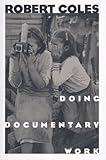Doing documentary work / Robert Coles.
Material type: TextPublication details: New York : New York Public Library, 1997.Description: 278 p. : illISBN:
TextPublication details: New York : New York Public Library, 1997.Description: 278 p. : illISBN: - 0195116291
- 9780195116298
- 070.1
- P 96 C693d 1997
| Item type | Current library | Home library | Collection | Shelving location | Call number | Vol info | Copy number | Status | Barcode | |
|---|---|---|---|---|---|---|---|---|---|---|
 Libro
Libro
|
Biblioteca Juan Bosch | Biblioteca Juan Bosch | Humanidades | Humanidades (4to. Piso) | P 96 C693d 1997 (Browse shelf(Opens below)) | 1 | 1 | Available | 00000092239 |
Browsing Biblioteca Juan Bosch shelves, Shelving location: Humanidades (4to. Piso), Collection: Humanidades Close shelf browser (Hides shelf browser)

|

|

|

|

|

|

|
||
| P 96 C548g 1990 Los guardianes de la libertad : propaganda, desinformación y consenso en los medios de comunicación de masas / | P 96 C559h 2012 Histoire politique et économique des médias en France / | P 96 C678c 1998 Communication criticism : developing your critical powers / | P 96 C693d 1997 Doing documentary work / | P 96 C732p 2003 Politico's guide to how to handle the media / | P 96 C734 2003 Communication and cyberspace : social interaction in an electronic environment / | P 96 C734 2005 Communiquer dans un monde en crise : images, representations et medias / |
In this thought-provoking volume, the renowned child psychiatrist Robert Coles, author of The Children of Crisis series, offers a penetrating look into the nature of documentary work. Utilizing the documentaries of writers, photographers, and filmmakers, Coles shows how their prose and pictures are influenced by the observers' frame of reference: their social and educational background, personal morals, and political beliefs. He discusses literary documentaries: James Agee's searching portrait of Depression-era tenant farmers, Let Us Now Praise Famous Men, and George Orwell's passionate description of England's coal miners, The Road to Wigan Pier. Like many documentarians, Coles argues, Agee and Orwell did not try to be objective, but instead showered praise on the "noble" poor and contempt on the more privileged classes (including themselves) for "exploiting" these workers. Documentary photographs can be equally revealing about the observer. Coles demonstrates how famous photographers such as Walker Evans and Dorthea Lange edited and cropped their pictures to produce a desired effect. Even the shield of the camera could not hide the presence of the photographer. Coles also illuminates his points through his personal portraits of William Carlos Williams; Robert Moses, one of the leaders of the Student Nonviolent Coordinating Committee during the 1960s; Erik H. Erikson, biographer of Mahatma Gandhi and Martin Luther; and others. Documentary work, Coles concludes, is a narrative constructed by the observer and is meant not only to represent "reality" but inevitably to interpret it.
There are no comments on this title.

